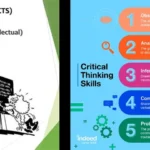What Are the Two Major Kinds of Thinking Styles? Unlocking the Secrets of Divergent and Convergent Thinking:Are you curious about the different ways our brains process information? Wondering what makes some people more creative while others excel at finding concrete solutions? Look no further! In this blog post, we will explore the fascinating world of thinking styles and uncover the two major kinds that shape our thought processes. Whether you’re an aspiring innovator or problem-solver, understanding these thinking styles can take your cognitive abilities to new heights. So, fasten your seatbelts and get ready to embark on a journey through the diverse landscape of human thinking. Let’s dive in and discover the secrets behind divergent and convergent thinking!
Understanding the Landscape of Thinking Styles
Human cognition is a vast and complex territory, and within this realm, the styles of thinking we employ can dramatically affect how we approach problems, solutions, and creative endeavors. Two predominate thinking styles that have been extensively researched and recognized are divergent thinking and convergent thinking. These styles are not just academic concepts; they play a critical role in innovation, decision-making, and everyday problem-solving.
Divergent Thinking: The Genesis of Creativity
Defining Divergent Thinking
Divergent thinking is synonymous with creativity and the generation of new possibilities. It involves breaking away from conventional patterns to explore multiple potential solutions. This type of thinking is characterized by a free-flowing, spontaneous, and non-linear approach that encourages the generation of numerous ideas.
The Role of Divergent Thinking in Problem-Solving
Engaging in divergent thinking is akin to casting a wide net. It’s about creating a variety of alternatives rather than seeking a single, correct answer. When faced with a challenge, divergent thinkers will brainstorm an array of solutions, each taking a unique perspective on the issue at hand. This expansive way of thinking is essential for innovation as it lays the groundwork for original and out-of-the-box ideas.
Techniques to Enhance Divergent Thinking
- Brainstorming without judgment: Encourage free thought and suspend criticism to allow ideas to flow.
- Playful exploration: Engage in activities that stimulate imagination, such as games or creative exercises.
- Questioning assumptions: Challenge the status quo to open up new avenues of thought.
Convergent Thinking: The Path to Concrete Solutions
Defining Convergent Thinking
Convergent thinking stands in contrast to divergent thinking. It’s about narrowing down the multitude of possibilities to find the best possible answer to a problem. This style of thinking is systematic and logical, emphasizing the use of critical thinking skills to arrive at solutions that are not only effective but also practical and often based on past experiences and knowledge.
The Importance of Convergent Thinking in Decision-Making
In decision-making scenarios, convergent thinking comes into play when it’s time to evaluate the ideas generated by divergent thinking. It’s the process of applying logical criteria to whittle down options and select the most viable solution. This critical phase is where ideas are tested against reality, and feasibility is the key factor.
Strategies to Strengthen Convergent Thinking
- Analytical reasoning: Develop the ability to assess situations and ideas critically.
- Decision-making frameworks: Utilize structured methods, like SWOT analysis, to evaluate options.
- Practical experimentation: Test ideas in real-world scenarios to gauge their effectiveness.
The Five Recognized Thinking Styles
While divergent and convergent thinking are the two major kinds, within these categories, there are five recognized thinking styles that further describe our cognitive approaches: synthesists, idealists, pragmatists, analysts, and realists. Each of these styles has distinct characteristics and preferences in processing information and solving problems.
- Synthesists are innovative and enjoy exploring complexities, often making connections between seemingly unrelated ideas.
- Idealists prioritize values and visions, often focusing on the ‘big picture’ and long-term possibilities.
- Pragmatists are practical, action-oriented thinkers who focus on the steps needed to achieve results.
- Analysts rely heavily on data and detailed analysis, methodically breaking down information.
- Realists are grounded in reality, focusing on facts, details, and practical applications of ideas.
Convergent and Divergent Thinking in Brainstorming
Brainstorming is a domain where both divergent and convergent thinking are actively employed. The process begins with divergent thinking, where participants are encouraged to voice all ideas without fear of judgment. It’s a time for imagination and creativity to reign. As the session progresses, convergent thinking is then applied to sort, refine, and select the ideas that are most promising and actionable.
The Three Modes Of Thinking
While divergent and convergent thinking cover a broad spectrum of cognitive processes, there is a third mode that often gets overlooked: lateral thinking. This style involves using both logic and imagination, often in a non-traditional way, to solve problems. Lateral thinking can lead to innovative solutions by making leaps and connections that are not immediately obvious.
Implementing Lateral Thinking
- Questioning the status quo: Look at problems from different angles to find new perspectives.
- Provocation: Use provocative statements or questions to disrupt conventional thinking patterns.
- Random input: Introduce unrelated ideas or stimuli to spark creative connections.
Final Thoughts
Understanding and utilizing the two major kinds of thinking styles, divergent and convergent, along with the nuanced sub-styles, is essential for personal and professional growth. Employing these thinking styles strategically can enhance problem-solving skills, boost creativity, and lead to more effective decision-making. By recognizing when to diverge and when to converge, and by not shying away from lateral thinking, we can expand our cognitive toolset and tackle challenges with a more holistic and versatile approach.
Whether you’re an innovator, a decision-maker, or someone who simply enjoys exploring the depths of human thought, embracing the full spectrum of these thinking styles can lead to profound insights and breakthroughs. The key is to balance them appropriately, according to the demands of the situation, and to cultivate an environment that nurtures both creative and analytical minds.
FAQ & Common Questions about Thinking Styles
Q: What are the two major kinds of thinking styles?
A: The two major kinds of thinking styles are convergent thinking and divergent thinking.
Q: What is convergent thinking?
A: Convergent thinking, also known as critical, vertical, analytical, or linear thinking, involves using logic to analyze and evaluate information.
Q: What is divergent thinking?
A: Divergent thinking, also known as creative or horizontal thinking, involves using imagination to generate new, novel, or useful ideas.
Q: What is lateral thinking?
A: Lateral thinking involves using both logic and imagination to solve problems and come up with innovative solutions.
Q: How do critical thinking and creative thinking relate to each other?
A: Critical thinking is the ability to logically consider information, while creative thinking is about generating new ideas. The best thinkers combine both critical and creative thinking to innovate and solve problems effectively.





